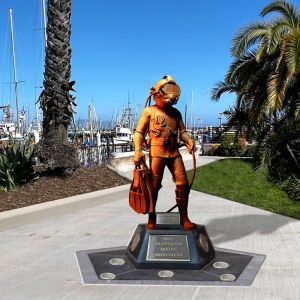Proposed Monument to Celebrate Santa Barbara’s Rich Deep-Sea Diving History – Noozhawk
[ad_1] Don Barthelmess has completed more than 5,000 dives, taught at Santa Barbara City College for more than 30 years and is a former board president of the Santa Barbara Maritime Museum. Although now retired, he’s not slowing down. His latest deep dive? It’s into Santa Barbara’s rich diving history. “Our local community and divers
[ad_1]
Don Barthelmess has completed more than 5,000 dives, taught at Santa Barbara City College for more than 30 years and is a former board president of the Santa Barbara Maritime Museum.
Although now retired, he’s not slowing down. His latest deep dive? It’s into Santa Barbara’s rich diving history.
“Our local community and divers today owe a debt of gratitude and thanks to the people who pioneered deep-sea, mixed gas diving in the 1960s, from right here in Santa Barbara,” Barthelmess told Noozhawk.
“This is a long overdue dream of the diving industry to honor the pioneers whose shoulders we have all stood upon in our careers. They advanced deep-sea intervention and made it safer for us today.”
Barthelmess is leading a team that wants to install an 8-foot-tall bronze statue outside the Breakwater Restaurant at the Santa Barbara Harbor to honor the area’s history and legacy of deep-water diving. “Dubbed “Going to Work,” the monument will depict a professional diver, circa 1982, wearing a locally made Kirby Morgan SuperLite 17 Diving Helmet.
Mixed-gas diving was developed by abalone divers in the 1950s and ’60s. The training for and the manufacturing of deep-sea diving gear that is used by 90% of the world’s navies occurred in Santa Barbara. SuperLite helmets used by most deep-sea divers were made and manufactured at a shop on Garden Street.


The 10-foot-tall bronze monument proposed at the Santa Barbara Harbor depicts a professional diver wearing a locally made Kirby Morgan SuperLite 17 Diving Helmet. (Deepwater Diving Monument Project illustration)
Santa Barbara has also been home to numerous commercial and scientific divers, and accomplished underwater photographers and cinematographers such as the late Mike deGruy.
“This monument is a testament to their life’s work,” Barthelmess said.
Barthelmess is working with the city’s Waterfront Department and local historian Leslie Leaney, a founding trustee of the Maritime Museum; Paul Guiver, who earned a British Empire Medal during the Persian Gulf War; and Tony Sexton, a British Royal Navy mine clearance diver.
The monument will be sculpted by Simi Valley artist Greg Polutanovich, who has created bronze sculptures of Sitting Bull and Presidents Abraham Lincoln and Ronald Reagan.
The sculpture will sit on a 2-foot-tall platform and be illuminated from the bottom. The Waterfront Department plans to remove four newspaper racks and some plantings next to two palm trees to install the sculpture. Nearby will be an information plaque with a QR code that can be scanned for more information about Santa Barbara’s dive history.
The plaque will read, “Commemorating Santa Barbara as the birthplace of deep-water diving and honoring pioneering divers and entrepreneurs locally and worldwide who developed technology and techniques to explore and preserve underwater resources.”
The group is fundraising privately for the $975,000 project, and is selling tiny statues of the sculpture to help. Taxpayer funds won’t be used for the undertaking, and Barthelmess said contractor labor, sculptor fees, permitting and architect costs are included in the total price tag.
“The waterfront and the city are honored to support this historic statue,” waterfront director Mike Wiltshire said. “Public art is a welcome addition to the harbor, especially a piece with such deep ties to the history of deepwater diving in Santa Barbara.”
This year is the 60th anniversary of when abalone diver Hugh “Dan” Wilson performed a 400-foot mixed-gas dive. The Santa Barbara resident left the harbor on the fishing boat Rio Janeiro on Nov. 3, 1962, according to Barthelmess. He took a support crew of abalone divers and some Brooks Institute photography students, who served as safety divers and documented the record dive.
Wilson dove more than 400 feet off the east end of Santa Cruz Island using oxy-helium mixed gas (Heliox) as his breathing gas, according to the monument’s website.
“Few people know that Santa Barbara is internationally recognized as the birthplace of deep-water diving,” Barthelmess said. “The pioneering and risky dives that began in 1962, resulted in the rapid expansion of deepwater oxy-helium diving from the shores of Santa Barbara to the North Sea and international waters.”
The project must still be approved by the Architectural Board of Review. Once fundraising is completed, Barthelmess said the crew is looking at the spring of 2024 for installation.
“Commemorating Santa Barbara as the birthplace of deep-water diving and honoring pioneering divers and entrepreneurs locally and worldwide who developed technology and techniques to explore and preserve underwater resources.”
— Noozhawk staff writer Joshua Molina can be reached at .(JavaScript must be enabled to view this email address). Follow Noozhawk on Twitter: @noozhawk, @NoozhawkNews and @NoozhawkBiz. Connect with Noozhawk on Facebook.
Adblock test (Why?)
[ad_2]
Source link









Comments